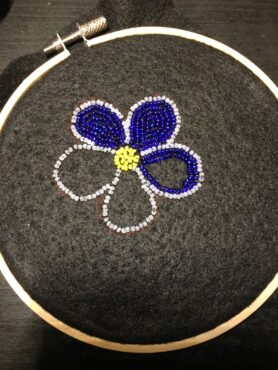Urban Indigeneity

I began to reconnect with my Métis culture on a Saturday in the final year of my undergrad.
In my first years at university, I learned as much as I could about Métis culture. I’d done the reading — Marilyn Dumont, Tenille K. Campbell, Jo-Ann Episkenew, Katherena Vermette — but I hadn’t lived it. I hadn’t grown up on a reserve, learned any traditional songs or dances, and I’d never owned a Métis sash. I didn’t feel like I had any right to claim my Métis heritage.
And then my dad approached me about applying for citizenship. Although my auntie and cousins had already gotten their membership cards to Métis Nation British Columbia, my process was a long one. There was a lot of back-and-forth over email. A lot of just missing each other’s phone calls. A lot of waiting. I began to get discouraged.
Maybe I just wasn’t Métis enough.
The more time passed, the more I felt like my right to claim my Indigeneity was wrapped up in this bureaucratic process. With COVID slowing everything down, I began to feel like I’d always be in this liminal state of being almost Métis.
What did it mean to be Métis, anyway? Was it all about who your family was, whose blood runs in your veins? Or was it something more?
On a random Saturday in October of 2021, I came across an Instagram post by my cousin who’d made Métis-style moccasins for her mother as a gift. Although I’m probably one of the only people who starts thinking about Christmas in October, I was inspired by her gift and sent her a message asking if she could teach me some traditional beadwork so that I could make my grandma a gift. Within a few minutes, my cousin replied with excitement. She sent over a list of all the materials I’d need to collect before we could begin.
Turns out, beadwork is expensive. The beads themselves are cheap, but it’s everything else that starts to add up. You need a slim needle and thread, a good pair of scissors, something to sew onto (I used felt sheets), and a piece of leather to hide all the messy threads underneath.
We decided on a flower pattern to start, and so began the first of the mishaps. See, my cousin lives in Prince George and I live in Mission. With so many kilometers between us, we turned to Zoom and Facebook Messenger to bridge the gap. She’d sent over a small flower pattern over messenger, and rather than printing it out and tracing it from the paper, I traced it directly from my phone onto the felt.
Only one problem: my phone had zoomed in on the photo and my pattern ended up being almost double the original size. Because of the virtual nature of our meetings, we didn’t realize this error until I was well into the second petal.
With nearly double the size came nearly double the work and before long my cousin was wrapping up her beading while I was still couching every bead on my third petal. Instead of leaving me to finish up the rest on my own — now that I’d learned the basics — my cousin stayed on the Zoom call and we spoke about our relatives. We started with the usual questions, how is your mom? Everyone staying healthy over there? And then we moved on to memories.
Having someone to share these stories with brought back details I’d almost forgotten.
Long after the Zoom call ended, I could still picture the vibrant red skirt that I’d worn at the Friendship Centre when my grade four class learned how to jingle dance. I could smell the butter melting in the pan when I’d been pulled out of math class to make bannock in seventh grade. I could feel the swaying of the bus on the way home from visiting a local university’s Indigenous department in grade 12.
With my citizenship card still pending, I’ve had to come to terms with my Indigeneity on my own. I can’t afford to wait for the paperwork, I am Métis right now.
And if I am Métis, then whatever I’m doing right now must be how to be Métis. Maybe I don’t have to be talented at beadwork (though my Grandma appreciated the wonky flower). Maybe I don’t have to read every book ever written by a Métis author. Maybe I don’t need to be surrounded by other Métis people to be part of the Métis community.
Just being me is being Métis.
One part Indigenous and one part settler, I am the product of a complicated past. I am the descendant of a woman who spent her whole life denying her Indigeneity to protect her family. I am the descendant of French colonizers. But I am also a twenty-four-year-old university student who spends a lot of her time on skytrains and buses, squinting her eyes against the glare of the sun through the smudged glass in order to complete her school readings.
I thread the needle between colonial guilt and Indigenous pride, and I do it all under the cover of my white skin. I couch my way through life, securing my future by doubling back on my past. I tie the knot of identity, only to pick up my needle again and re-thread it.








